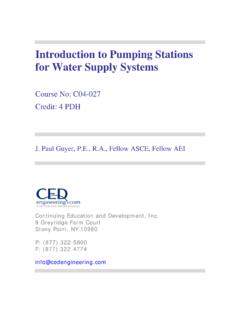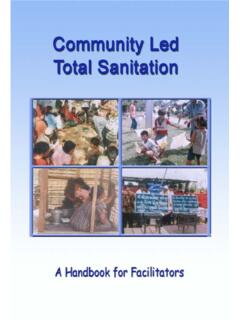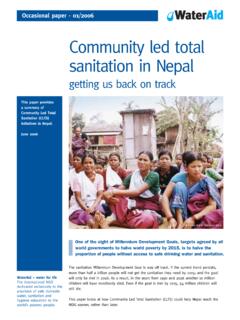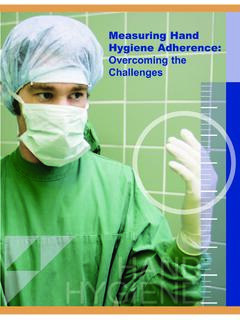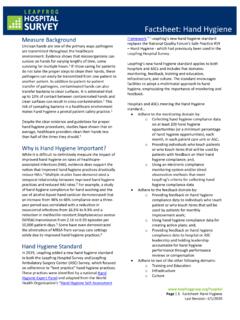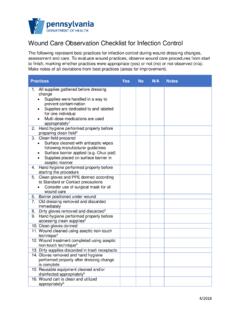Transcription of Hygiene Promotion Training for Hygiene Promoters
1 Hygiene Promotion Training for Hygiene Promoters & 1 Module 2 Handouts Module 3 Handouts 2 This manual contains trainingmaterials and handouts to enablefacilitators to rapidly prepare trainingfor different levels of hygienepromoters. It can also serve as a resource for selfdirected learning by both hygienepromoters and others involved insupporting or managing WASH interventions. 3 Table of contents 4 List of All Handouts & 5 Module 2: Useful to know available 9 9 Transmission patterns and preventive measures for water- and sanitation-related diseases common in emergency 10 Faecal-Oral 11 Diarrhoea Fact 18 WHO Cholera Fact 22 WHO Hepatitis A 25 WHO Hepatitis E Fact 27 WHO Dengue and dengue haemorrhagic 29 WHO Malaria 32 Scabies disease fact 34 How to do matrix and pair wise 35 Hygiene Promotion and 36 Gender 39 Gender Checklist for WASH 40 Protection 43 Hygiene Promotion and HIV and 44 HIV/AIDS Transmission 46 Community Participation and Gender 47 Participation Ladder 49 Roles and Statements for the Power 50 How to do Venn 51 Hygiene
2 Promotion 52 Behaviour Change 53 Communication for Social 56 Guidelines for Developing 58 Designing a 59 PHAST (Participatory Hygiene and Sanitation Transformation).. 61 Social 63 Child To 65 Role play, drama, street theatre and puppet 69 Role of the Hygiene 73 Community Management Briefing 74 Bujumbura Case 79 Example Roles and Responsibilities of Water Committee 82 Module 3: Agency and Context specific available 83 Role of the Hygiene 83 Designing the baseline 84 Example Water, Sanitation and Hygiene Survey 87 Guidance Notes for Questionnaire 90 Cholera control - Toolkit for Red Cross 91 MALARIA QUIZ 94 Malaria Focus Group Discussion 96 4 Introduction WASH Hygiene Promotion Handouts Module 2 & 3 Introduction The Training sessions are divided into four key modules.
3 For Modules 1, 2, and 3 the sessions have also been structured around 3 Key Knowledge and Skill Areas: context, skills and job specifics. Review & Evaluation of these areas is also a vital part of the Training as shown below. Module 1 Essential to Know Module 2 Useful to Know Module 3 Situation or agency specific Module 4 Sessions for Co-ordinators Training Sessions Context Hygiene Promotion Skills Hygiene Promotion Job specifics Review & Evaluation Content Learning about the current context, background information and Hygiene risks Learning about the skills, methods and approaches used in HP work. Learning about the specific job participants are expected to do and practice using the skills Reviewing course and session objectives.
4 Monitoring work and evaluating learning Unlike Modules 1 -3 the sessions in Module 4 have been grouped into 4 categories which relate to the generic job description for a Hygiene Promotion coordinator: Programme Approach, Information Management, Implementation Resources Management. The handouts are optional and may need to be modified to suit the specific context by the trainer. Additional handouts may be provided where necessary by making use of the PowerPoint slides as indicated in the session plans. The majority of handouts have been taken or adapted from existing material and where applicable the sources are given. They have been grouped together in one manual to facilitate use.
5 Handouts do not exist for every session. 5 Introduction WASH Hygiene Promotion Handouts Module 2 & 3 List of All Handouts & Resources Module 1 Essential to Know Session Handouts/PowerPoint Slides Session Handouts/PowerPoint Slides WASH cluster and co-ordination Cluster Overview Communication skills Listening Techniques observation and Listening slide 31 Public health in emergencies Public Health Model Slide 4 Communication skills II Communication Worksheet Training and communication skills Hygiene Promotion in emergencies Terminology and Definitions Hygiene Promotion briefing paper Hygiene Promotion Slides 10-20 Participatory methods Facilitation skills for participatory methods
6 Instructions for exercises Key water and sanitation priorities Fewtrell Diagram Slide 22 Adult learning How adults learn PowerPoint slide 41 Key actions to prevent diarrhoea F diagram (also slides 24 & 25) Instructions for management of diarrhoea Focus group discussion Focus Group Discussion Focus group discussion sample questions Analysing qualitative data and reporting Participation and Accountability Humanitarian accountability and Hygiene Promotion PowerPoint slide 35 Job Description Hygiene Promoter job description PowerPoint Slide 43 Assessment and baseline Qualitative and Quantitative Assessment Leading Questions Assessment Methods Overview of Data Collection for Hygiene Promotion Example rapid assessment checklist Example observation guide for an exploratory walk PowerPoint Slides 45 -48 Hygiene Kits.
7 Selection & Distribution Hygiene Related Non Food Items Briefing Paper Hygiene Kit Monitoring Form Selection and support of Community Mobilisers Information on community mobilisers and example job description Community mobiliser attributes Community InvolvemeDesign of facilities PowerPoint Slides 50 and 51 Introduction to Working with Children Child protection good practice guide Child Protection Scenarios Child to Child Activity Sheets Training Practice HP 2 Training for Community Mobilisers 6 Introduction WASH Hygiene Promotion Handouts Module 2 & 3 Example activities for children Children and Learning PowerPoint slides 53-56 Monitoring Example of a WASH logical framework matrix Indicators for monitoring Hygiene Promotion in emergencies Example Hygiene Promotion monitoring form Examples of PHAST monitoring forms Monitoring Exercise Example SMART and not so SMART indicators Example review session Example Quiz Sheets Module 2 Useful to Know Session Handouts/PowerPoint Slides Session Handouts/PowerPoint Slides Water & Sanitation Related Diseases PowerPoint slide 3 F diagram WASH related diseases Table of transmission of diseases Disease fact sheets (Hepatitis A, Hepatitis E, Malaria, Cholera, Dengue, Diarrhoea, Scabies)
8 Pair wise ranking instructions Introduction to Sphere Minimum standards for water, sanitation and Hygiene Promotion & Minimum standards for shelter and non food items (available from ) PowerPoint Slide 5-9 Hygiene Promotion and Sphere Introduction to Gender Gender Roles Exercise Gender Checklist PowerPoint Slide 11-13 Introduction to Protection Protection Handout Introduction to HIV/AIDS Hygiene Promotion and HIV/AIDS HIV transmission three pile sorting exercise Community Participation Gender and community participation worksheet Participation Ladder Exercise PowerPoint Slides 11-13 Roles and statements for the power walk (optional exercise) How to do Venn Diagrams (optional exercise)
9 Behaviour Change and Social Change Catalyse Model see slide 21 Behaviour Change Models Communication for social change and Hygiene Promotion PowerPoint Slides 19-22 Use of Visual Aids Guidelines for designing posters Designing a leaflet PowerPoint Slides 24-26 Other Promotional Methods Overview of social marketing Overview of PHAST Overview of Child to Community Management of Facilities Oxfam Briefing Document Bujumbura Case Study Roles of Committee Members 7 Introduction WASH Hygiene Promotion Handouts Module 2 & 3 Child Using role plays and drama PowerPoint Slides 28-32 Module 3 Situation or Agency specific sessions Session Handouts/PowerPoint Slides Session Handouts/PowerPoint Slides Introduction to Baseline Survey Designing baseline study PowerPoint Slides 3-6 Questionnaire Survey Example Questionnaire Guidance Notes for carrying out surveys Use of ORT F Diagram Instructions for management of diarrhoea (see session on Key Actions to Prevent Diarrhoea) Cholera Control Issues Cholera Toolkit Factsheet on cholera (from session on water and sanitation related diseases) Malaria Control Issues Malaria Quiz PowerPoint slides 8 and 9 Focus group discussion framework RBM Information Sheet (see ) Module 4 Optional sessions for HP Co-ordinators (available end 2009)
10 Session Handouts/PowerPoint Slides Session Handouts/PowerPoint Slides Evidence Base Evidence Base Background One page handouts on PHAST and Social Marketing (from Module 2) PowerPoint Slides 2-4 Development versus Emergency Factors affecting sustainability of water systems PowerPoint Slides 5-15 Managing Accountability Accountability discussion group work Sources of Humanitarian principles Listen First PowerPoint Slides 16-20 Advocacy WASH advocacy in emergencies Planning advocacy initiatives WASH advocacy case study WASH advocacy case study analysis PowerPoint Slides 22-26 Designing and managing an assessment WASH CAT assessment flowcharts Basic checklist for planning Hygiene Promotion PowerPoint Slides 27-31 Data analysis and reporting Analysing qualitative & quantitative data Example questionnaire (see Module 3)



